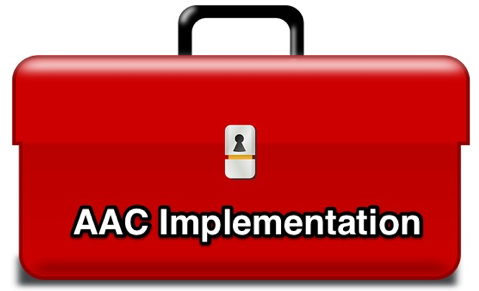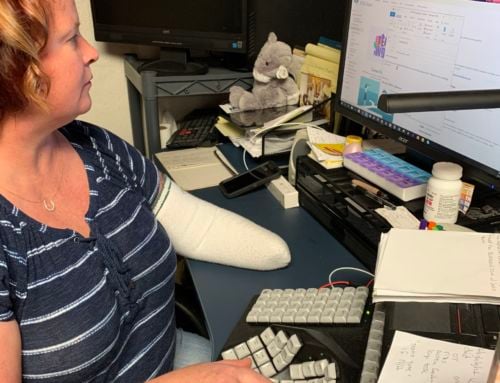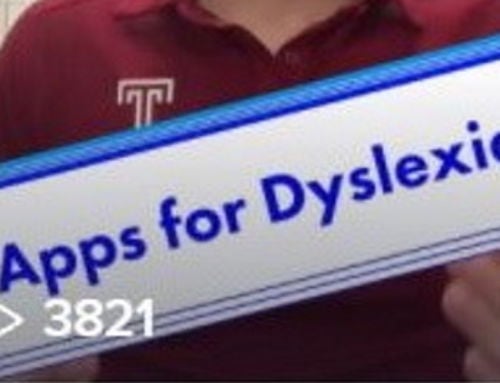AT Etiquette Tips (and Regrets)
Thank you, everyone, who contributed to this article (you know who you are).
![]()
Where did the idea for a post on Assistive Technology (AT) etiquette come from? A foray into Twitter introduced me to #BlindPeopleUsePhones and the hashtag’s history. I was looking for ways to tag our recent article on teaching iDevices to blind users when I tripped across it. Apparently, the hashtag began when a Facebook user spied a woman holding a white cane while consulting her smartphone. A photo was posted with sarcasm, doubting the cane user is blind. Vigorous community education ensued and #BlindPeopleUsePhones was born (thank you Royal National Institute of Blind People).
This is, admittedly, more than a lapse in etiquette. But it suggests that when it comes to AT and respecting AT users, more information in cyberspace is a good thing. So in honor of disability employment awareness month, here are AT etiquette tips (and regrets) everyone should consider.
Ask Before Helping
My spouse once helped dislodge a person’s wheelchair caught dangerously between a train and a subway platform. She acted quickly, and–to her horror–without much help from others. In cases of imminent danger, don’t hesitate!
Unfortunately, the more common experience reported by wheelchair users is their getting manhandled by strangers unnecessarily. Well-meaning people (and others) often break into an AT user’s personal space and take hold of their AT in order “to help.” Rarely is this appropriate or necessary.
A colleague in Massachusetts reports that her husband is sometimes forcibly repositioned at the doctor’s office. A health care provider will grab his powerchair’s joystick without asking and move him where she wants him to be. Others have tried pushing his wheelchair from behind to go faster.
One “maker” approach to this problem was deployed by a woman in the UK; she added spikes to her handlebars to discourage random strangers from pushing her.
No Means No
Do ask if someone would like assistance. A person navigating with a white cane might appreciate grasping your arm above the elbow for assistance finding a restaurant’s restroom or negotiating an unfamiliar entrance, for example. But if that person declines your offer, that’s the end of it. This is not a time to argue that you really don’t mind assisting or doubting they could possibly want to go it alone.
From Facebook:
“A lady grabbed my wrist in one hand and my cane in the other after I’d told her no three times […]. Maybe not every blind person gets grabbed by strangers, has directions shouted at them by people who don’t even know where they’re going, gets moved out of the way wordlessly like they’re a piece of luggage [….] I’m a human being, an adult who can determine where I want to go.”
AT is Not Furniture
Avoid using a person’s chair as a footrest or a coat hanger or as a support for standing up. Yes, you may kneel or sit to get eye level, a common courtesy, but getting up should be accomplished independent of touching that person’s wheelchair.
From Facebook: “If I want to touch you I will always ask first. Wheelchair users expect the same courtesy. Please don’t lean on us, push us out of the way, hang bags on our chairs, use the handles to steady yourself […]”
My colleague in Massachusetts notes, “The rules are different for me [his spouse]. His chair is an extension of his body, and touching his chair, by me, is affection.”
Treat AT as an Extension of the Body
Most of the tips in this post correlate to this one overarching principle: assistive technology as an extension of a person’s personal space, perhaps best understood as an extension of their body. Do not touch (without asking) and ask with this awareness in mind.
Gulp. Here’s a regret:
I regret not understanding the level of trust it took for a friend to let me take her titanium wheelchair for a joy ride at the AT Industry Association (ATIA) conference (with SmartDrive power assist!) She swears she offered, but I did not fully appreciate her wheelchair as an extension of her person and the vulnerability such a loan entailed. After my spin, a colleague of hers tried the chair and tipped backward. What if we’d damaged the chair? As this scene played out, I understood a gravity to this otherwise joyful moment (and felt the old adage, “It’s all fun and games until somebody gets hurt” in a new way).
My friend, however, assures me: “It is fine to ask someone you know well,” but she acknowledges, “if you don’t know the person, it is not appropriate to ask to try [their wheelchair].”
About AT in general, she says, “I think how you ask, when you ask, and respecting the user’s response is what is critical.” An AT conference, she notes, is a great place to ask about a person’s AT. But don’t forget to listen to their response. “If they engage, great. If not, move on. It’s about treating individuals with disabilities as people and respecting everyone equally with a right to share or not share anything about themselves or their technology, how they choose, the way they choose.”
Treat AT as an Extension of the Body, Even When Left On Its Own
Don’t move someone’s cane or rollator from where they have left it. It may be positioned at an angle necessary for them to use it from where they are seated. And if it’s a white cane, it is where the user knows where to find it (this is also true of anything, AT or not, that a person who is blind is using or has left in place).
Service Dogs Are Not AT, But the Same Rules Apply
Service dogs are not AT but we still shouldn’t touch them without asking. Service dogs at work should not be distracted. Did I mention animals are not AT? They are not AT (thank you, Amy Goldman).
“Asking to pet [my service dog], making noises or gestures to get her attention, or simply giving her eye contact can disrupt our flow, cause her to be distracted and potentially put us both in danger.” —Sassy Wyatt
Have Patience with People Who Use Speech Generating Devices
Speech generating devices (SGDs) produce spoken messages created and/or selected by their users. Don’t look to the device for what a person will say; wait to hear their message and look at the person with whom you are communicating. There is similar etiquette for communicating with a person who uses a sign language interpreter (look to the person who is deaf and not their interpreter when communicating). It is also a common courtesy to give a person using an SGD questions ahead of time so that answers may be prepared, such as for a meeting or an interview.
Here’s a regret:
That time (also at ATIA) when I was talking with a person who uses an SGD and was a tad excited to see how it worked and peered around to their hands crafting a message. I then–yes I did this–read it aloud off the screen only to realize too late that they would fire off the message audibly. I could feel their frustration as they did so and understood, all at once, about personal space and SGDs.
Avoid Common Assumptions about Hearing Aids and Cochlear Implants
It’s not appropriate to raise your voice for a person with hearing aids or ask a person with hearing aids to turn them up. Shouting will distort your words. Hearing aids are carefully calibrated at normal speaking levels for the user.
A friend who is deaf and wears hearing aids says, “Don’t say ‘My aunt/grandmother/grandpa etc. has hearing aids. They work so well! He/she can hear everything I say.’ Because that means they either have a mild hearing loss or they’re just really good at faking it.”
She says she is asked frequently why she doesn’t just have cochlear implants. She notes that people seem to believe hearing aids and cochlear implants “fix” hearing like eyeglasses may correct vision. “But you’re still deaf and still can have problems understanding speech or noise.”
Avoid Common Assumptions about White Canes and Glasses
Most people who are legally blind have some sight. Not everyone who uses a white cane is completely blind. Some blind people use glasses as well as white canes… as well as smartphones. Some people use white canes only for certain situations, such as climbing stairs. One friend reports that some blind people put their white canes away while waiting for their Uber (because of their experience with drivers taking off when they see their rider is blind).
Avoid Common Assumptions about Accessible Parking Permits
Don’t look surprised if a wheelchair user can stand or walk. Check out #AmbulatoryWheelchairUsersExist. Not everyone with an accessible parking permit will exit their car in a wheelchair, either. Not everyone with an accessible parking permit uses a wheelchair (some disabilities are “hidden”).
Van-accessible parking spaces should be reserved for… accessible vans. So if you have an accessible parking permit but you don’t need a van space, leave it open. Van users need that extra clearance for wheelchair lift access.
Speech To Text Has Come a Long Way, But Not Far Enough
Yes, there are some great apps and other software out there turning spoken words into text on a computer screen. For some speakers, this option can transcribe fairly accurately. For others, this is not the case. Avoid pressuring colleagues and others to accept speech-to-text options in place of sign language interpreters, CART transcribers or another human-powered captioning option. Ask directly, What is your preferred method of communicating and participating? Listen and respond appropriately.
A friend who is deaf wrote me, “Who wants to stare at a computer screen instead of at a person? Interpreters and a captioner are better.”
“Sure,” I wrote back, “But I’ll never forget the workout I gave you inviting you to that SILC meeting [all about the budget]. With an interpreter, you can’t just look away and tune them out when the talk is crazy boring. I did not realize this. I felt so badly.”
“Oh, believe me,” she replied, “my eyes might be on the interpreter during a boring topic, but my mind is not!”
Lesson learned: ask, respond accordingly, and trust the outcome.
Learn more: Disability Etiquette: Tips On Interacting With People With Disabilities from the United Spinal Association.
Monthly Blog Digest
Search the blog
State AT Program Blogs
California
Florida
Indiana
Kentucky
Louisiana
Maryland
Massachusetts
Michigan
Montana
North Carolina
North Dakota
Utah
State AT Program Blogs
The AT3 Center, the Association of AT Act Programs (ATAP), and the Administration on Community Living (ACL) make no endorsement, representation, or warranty expressed or implied for any product, device, or information set forth in this blog. The AT3 Center, ATAP, and ACL have not examined, reviewed, or tested any product or device hereto referred.








